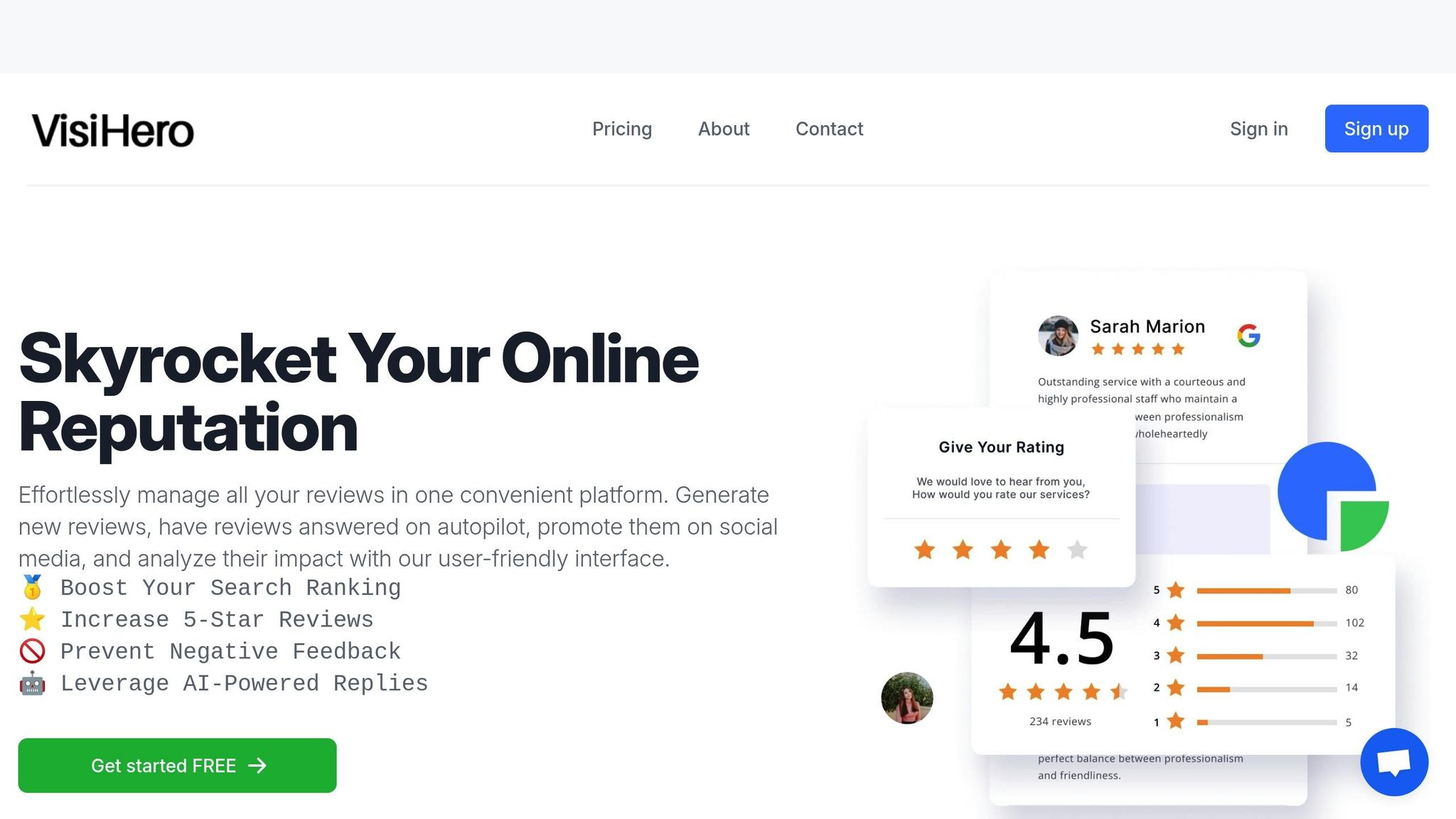Local SEO and review management are both essential for driving traffic, but they work in different ways. Here’s a quick breakdown:
- Local SEO helps your business appear in location-based searches (e.g., "coffee shop near me"). It boosts visibility in Google Maps and search results, driving foot traffic and online visits.
- Review Management builds trust and influences buying decisions by encouraging and responding to customer reviews. Businesses with higher star ratings and recent reviews are more likely to attract customers.
Key Insights
- Local SEO: 78% of local searches lead to a store visit within 24 hours, and 42% of clicks go to the Google Map Pack.
- Review Management: 96% of people read reviews, and businesses with strong reputations can charge up to 22% more.
Quick Comparison
| Aspect | Local SEO | Review Management |
|---|---|---|
| Focus | Visibility in search results | Building trust through reviews |
| Traffic Type | Online searches → Store visits | Customer trust → Purchase decisions |
| Key Benefit | Attracts customers actively searching | Shapes buying decisions with social proof |
| Best For | Businesses targeting local searchers | Businesses needing stronger reputations |
Local SEO and Online Reviews: Key Strategies for Business …
Local SEO Explained
Local SEO helps your business connect with customers in your area by improving your visibility in local search results.
Local SEO Basics
Local SEO ensures your business appears when users search for services nearby. Did you know that 30% of mobile searches are location-focused? Even more impressive, 78% of these users visit a business within 24 hours. This strategy is all about optimizing your digital presence to show up in Google’s local pack (the map results) and standard organic search listings.
By using local SEO, you can signal to Google where you’re located, what services you offer, and why you’re a trusted choice. This improves your chances of ranking higher in local and organic search results.
Let’s dive into the key methods for improving your local visibility.
Main Local SEO Methods
Your Google Business Profile is at the heart of local SEO. A survey of SEO experts highlights the most important factors for ranking in the local map pack:
| Component | Impact | Best Practice |
|---|---|---|
| Google Business Profile | Major ranking factor (36%) | Fill out every section, upload photos, and keep your hours up to date. |
| Reviews | Second most important (17%) | Encourage reviews and respond to them regularly. |
| Name, address, phone (NAP) | Builds local trust | Ensure your business info is consistent across all directories. |
| Local Keywords | Attracts targeted traffic | Use neighborhood names and local landmarks in your content. |
| Backlinks | Boosts organic rankings (31%) | Partner with local businesses and list your site in local directories. |
| On-Page SEO | Key organic signal (34%) | Add location-specific terms to meta titles and descriptions. |
Optimizing your Google Business Profile alone can make customers 70% more likely to visit your location and 50% more likely to consider making a purchase.
These strategies directly lead to more visitors, both online and in person.
Traffic Benefits of Local SEO
Local SEO drives noticeable increases in traffic:
- Digital Traffic: Searches for "shopping near me" on Google Maps have more than doubled year over year. Plus, 66% of consumers use Google to find local businesses.
- In-Person Visits: After conducting a local search, 88% of smartphone users visit a relevant store within a week, and 78% of these searches lead to local purchases.
"One of the best things you can do if you’re targeting a specific neighborhood, city, or region is to write an in-depth guide to that region. Mention things that people are already familiar with, for example, popular places in the region, landmarks, historical markers, or anything you can work into the copy naturally without keyword stuffing to tell Google and readers that you’re familiar with the area."
- Rebekah Barton, professional content writer and blogger
Up next, we’ll look at how managing customer reviews can further boost traffic and build trust.
Review Management Explained
Review management works hand-in-hand with local SEO by transforming customer feedback into a tool for driving traffic. It involves collecting, monitoring, and responding to reviews across different platforms to increase their quantity, keep them recent, and build social proof – all while steering clear of incentives or spam.
How Reviews Affect Sales
Customer reviews play a major role in how people decide where to spend their money. For example, only 11% of consumers are willing to engage with a business that has a 2-star rating. Google’s algorithm also places growing importance on reviews, with star ratings becoming the 8th most important local ranking factor in 2020 – an impressive leap of 16 spots in just three years.
Beyond search rankings, reviews influence trust and purchasing decisions:
- 86% of consumers say reviews are either the most or a somewhat important factor in deciding whether a business is trustworthy.
- 79% of consumers focus most of their review-reading time on Google.
- 42% check reviews and testimonials directly on a company’s website.
Review Management Tools and Tasks
Platforms like VisiHero use AI to simplify review management. These tools can automate review requests through email and SMS, provide quick responses, and analyze customer sentiment. Key daily tasks include tracking new reviews, responding promptly, identifying trends, and addressing customer concerns.
As Miriam Ellis puts it, reviewers act as a massive, unpaid salesforce, sharing your brand’s story with others.
sbb-itb-0a038f8
Local SEO vs Review Management: Direct Comparison
Local SEO and review management work differently to drive traffic, each offering unique benefits. Let’s break down their strengths so you can decide how to allocate your efforts.
Side-by-Side Comparison
| Aspect | Local SEO | Review Management |
|---|---|---|
| Traffic Type | Mobile searches lead to store visits | Ratings influence purchase decisions |
| Core Benefit | • Boosts visibility in map results • Brings in immediate foot traffic • Targets customers ready to buy |
• Builds lasting trust • Shapes buying choices • Provides social proof |
These differences highlight how each approach can excel on its own – or work together for even better results.
Best Uses for Each Method
When Local SEO Works Best:
Local SEO thrives when search intent is high. For instance, 94% of top-performing businesses prioritize local SEO. If you operate in multiple areas, creating dedicated landing pages for each location can improve your visibility in those specific markets.
When Review Management Stands Out:
Reviews are critical for building trust. Studies show 62% of people trust negative reviews more, over 60% read businesses’ responses, and 70% are motivated to leave reviews when companies actively engage.
Up next, see how combining these strategies can boost both your visibility and credibility.
Combining Local SEO and Reviews
How Both Methods Work Together
When local SEO and review management are combined, they boost both visibility and trust. Nearly 46% of searches have local intent, and 95% of consumers look at online ratings before deciding to buy. Google now ranks star ratings as the eighth most important factor for local pack rankings, showing just how heavily reviews influence local search.
Steps to Combine Both Methods
-
Audit Your NAP and Local Pages
Ensure your Name, Address, and Phone Number (NAP) are consistent across platforms, and create dedicated local landing pages for better search visibility. -
Manage Reviews Effectively
Keep reviews current by encouraging customers to leave feedback regularly. Reviews from the past month carry the most weight, so don’t let them go stale. Respond to reviews promptly to show you’re engaged and listening. -
Use Local Citations
List your business on trusted directories like Yelp, TripAdvisor, Facebook, and Instagram. These citations help reinforce your local SEO efforts while showcasing customer feedback.
Using VisiHero for Both Strategies

VisiHero simplifies local SEO and review management with tools like:
- AI-Powered Responses: Improves local pack signals and ensures timely replies to reviews.
- Automated Review Requests: Keeps reviews coming in, helping build trust and improve search visibility.
- Sentiment Analysis: Identifies local keywords and monitors customer satisfaction on a larger scale.
These tools make it easier to manage your Google Business Profile while enhancing customer engagement and search performance.
Conclusion
Main Points Review
Local SEO and review management play crucial roles in driving both visibility and customer actions. Here’s a quick breakdown:
- Local SEO boosts discovery: Nearly 42% of local searches result in clicks on the Map Pack, and 78% of these searches lead to offline purchases.
- Review management influences conversions: A whopping 96% of customers read reviews, and businesses with strong reputations can charge up to 22% more.
- Local searches account for 25% of site traffic, emphasizing the importance of regular optimization.
Next Steps
To make the most of these insights, focus on these actionable steps:
-
Optimize Your Local Presence
Make sure your NAP (Name, Address, Phone Number) is accurate across all directories, and create landing pages tailored to specific locations. Why? Because 63% of consumers avoid businesses with incorrect listings. -
Improve Review Management
Set up automated review requests and aim to respond to reviews within two days. This matters because 60% of reviewers expect timely responses, and 63% are willing to revise negative feedback if their concerns are addressed. -
Track and Measure Progress
Regularly monitor local rankings, review response rates, and conversions. Data shows that 94% of top-performing businesses have a dedicated local SEO strategy, proving that consistent tracking and adjustments are key.
